Contributory members are able to log private notes and comments about each site
Sites Anne T has logged. View this log as a table or view the most recent logs from everyone
The Sill
Trip No.140 Entry No.3 Date Added: 25th Jun 2019
Site Type: Museum
Country: England (Northumberland)
Visited: Yes on 23rd Jun 2019. My rating: Condition 4 Ambience 3 Access 5

The Sill submitted by Anne T on 25th Jun 2019. The Sill building, as seen from its north eastern corner. It is located in Once Brewed, immediately next to the B6318 (Old Military Road).
(View photo, vote or add a comment)
Log Text: The Sill, Once Brewed: After visiting Great Chesters/Aesica, we popped over to the Sill for a cup of tea and a bowl of soup. It took three attempts to get our (simple) order correct, although as the Sill was popular with walkers, it meant queuing up each time to get the correct items.
I was curious to see if Tynedale North of the Wall Archaeology Group had their display about their surveys at Edges Green and Cleughfoot. We walked round the very small exhibition, which included a piece of rock art (on loan from the Great North Museum) and an inscribed Roman stone, but could see nothing from the group.
It was difficult to know if the display was aimed at adults or children; having wandered around it, most of it seemed aimed at the younger age group.
A pleasant place for a rest and refreshments, but I had expected more of a museum.
Tony's Patch 1
Trip No.141 Entry No.4 Date Added: 1st Jul 2019
Site Type: Rock Art
Country: England (Northumberland)
Visited: Yes on 30th Jun 2019. My rating: Condition 3 Ambience 3 Access 4

Tony's Patch 1 submitted by Anne T on 1st Jul 2019. The irregular 'cups' seen from further down slope, using flash to give a bit more contrast/depth. At the time of our visit, on the warmest weekend of the year (so far) the heavens opened and we got drenched. The light was so bad it was like dusk.
(View photo, vote or add a comment)
Log Text: Tony's Patch Rock Art: The information for this nature reserve said there was room to park one car by the stile into the field at NY 81961 65368, and indeed there was, but only just. As we readied ourselves to walk towards the wood, the first spots of rain started, but we decided it would only be a short shower, so thought we'd walk down anyway, and if the rain got heavy, we'd be sheltered in the wood. Ha!
From the stile we headed ENE across this field of, for the most part, knee high grass, heading towards the gate into the nature reserve. Then followed the path through the wood, finding a small turn off to our right to this stone at about NY 82262 65565. By this time, the rain was hammering down, and we had started to get soaked.
I don't think anyone had been here for some time, as the branches from the trees had grown right over the rock and I kept getting caught up in them.
We eventually found the cup marks at the bottom, right hand side of the rock, where the rock starts to become 'undercut'. We needed to push some of the bracken aside to see them.
I really don't understand how NADRAP could have classified these are having ben made by water running over the rock surface? Where are the water channels that would have worn? Or if these were solution holes, the rock must have been in a different position for these to form.
Having photographed these as best I could in the very low light levels, we headed back to the car. By this time, the grass in the field was wet, but we waded through. I don't think my walking sandals will ever be quite the same!
Joicey Shaft a
Trip No.141 Entry No.1 Date Added: 1st Jul 2019
Site Type: Rock Art
Country: England (Northumberland)
Visited: Yes on 30th Jun 2019. My rating: Condition 3 Ambience 3 Access 4
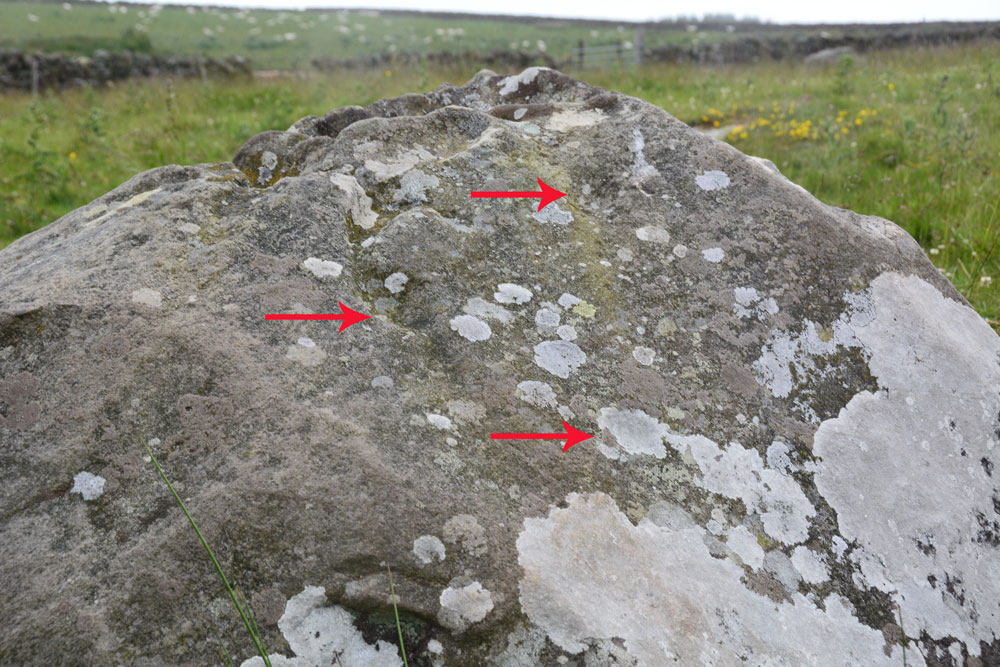
Joicey Shaft a submitted by Anne T on 1st Jul 2019. ERA/NADRAP says there are two cups here, the one to the east "fed by a natural gully from above". We thought we found three cups, marked with the red arrows, but there were so many erosion features, it was difficult to be certain.
(View photo, vote or add a comment)
Log Text: Joicey Shaft A: With the most of the rest of the UK enjoying warm sunshine, up in this part of Northumberland, the storm clouds had gathered. Having checked the weather forecast to make sure rain wasn't due to arrive until this evening, we set off to find these rock art panels, within easy reach of a road. This road was marked on the old OS map as a bridle path, but on the modern OS map it is now a metalled, yellow road, indicating it can be driven down.
OK, the road isn't the best, being potholed in parts, but the stone can be found just through a gate across the road at NY 82906 66462. Both boulders are on the northern side of the road, about 40m apart.
Being here was really wierd, as holes had been drilled in the northern-most gatepost, and as the wind howled through them, it played a tune, the 'melody' varying between different notes dependant upon the width of the hole.
I managed to photograph panel A before the rain started to come down, then we had to sit in the car for 10 minutes or so before there was a break in the clouds.
In walking back from panel B, I spotted through the gate on the south side of the road, a lump which looked like a cairn. I almost dismissed it as a farmer's manure dump, but realised the tractor track respected its western side (albeit cutting it a little). Andrew has just pointed out it is shown on the 1860 OS map.
Joicey Shaft b
Trip No.141 Entry No.2 Date Added: 1st Jul 2019
Site Type: Rock Art
Country: England (Northumberland)
Visited: Yes on 30th Jun 2019. My rating: Condition 3 Ambience 3 Access 4
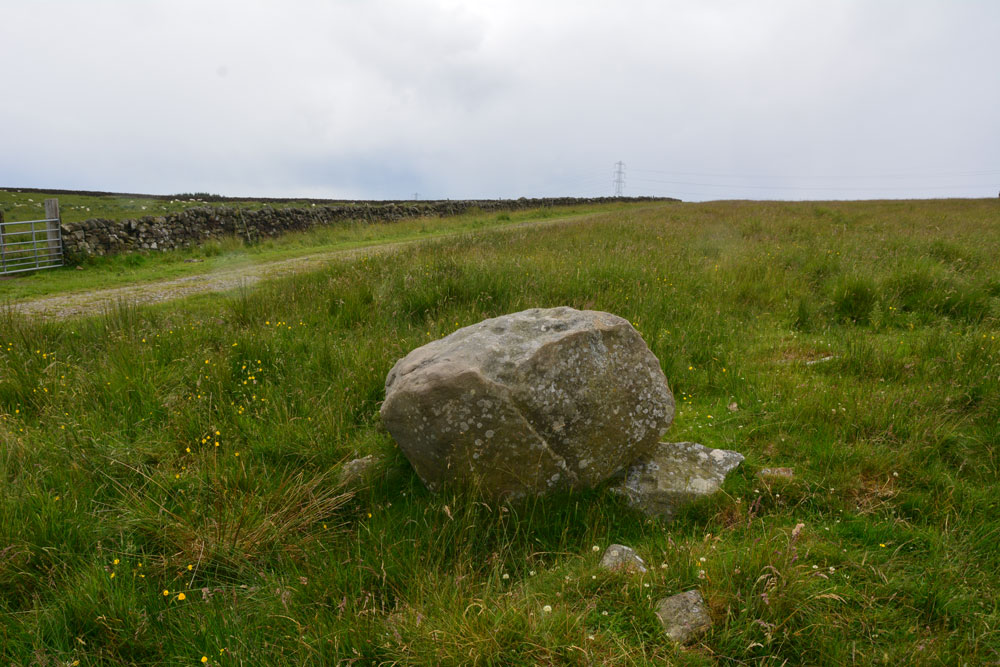
Joicey Shaft b submitted by Anne T on 1st Jul 2019. Photograph showing the Panel B boulder in relation to the track running to its south. The boulder sits on top of other stones, apparently the remains of an old field boundary/dry stone wall.
(View photo, vote or add a comment)
Log Text: Joicey Shaft B: This boulder is only 40m or so to the WSW of panel A, and is the only other large boulder in the field near this location. It is propped on top of other stones, part of the demolished field wall that ERA/NADRAP talk about.
ERA/NADRAP talk about two possible cup marks, which I found by comparing the shape of the stone with the NADRAP drawings. We also thought we saw two more, but these may be just solution holes or natural erosion.
Joicey Shaft Cairn
Trip No.141 Entry No.3 Date Added: 1st Jul 2019
Site Type: Round Barrow(s)
Country: England (Northumberland)
Visited: Yes on 30th Jun 2019. My rating: Condition 2 Ambience 3 Access 4
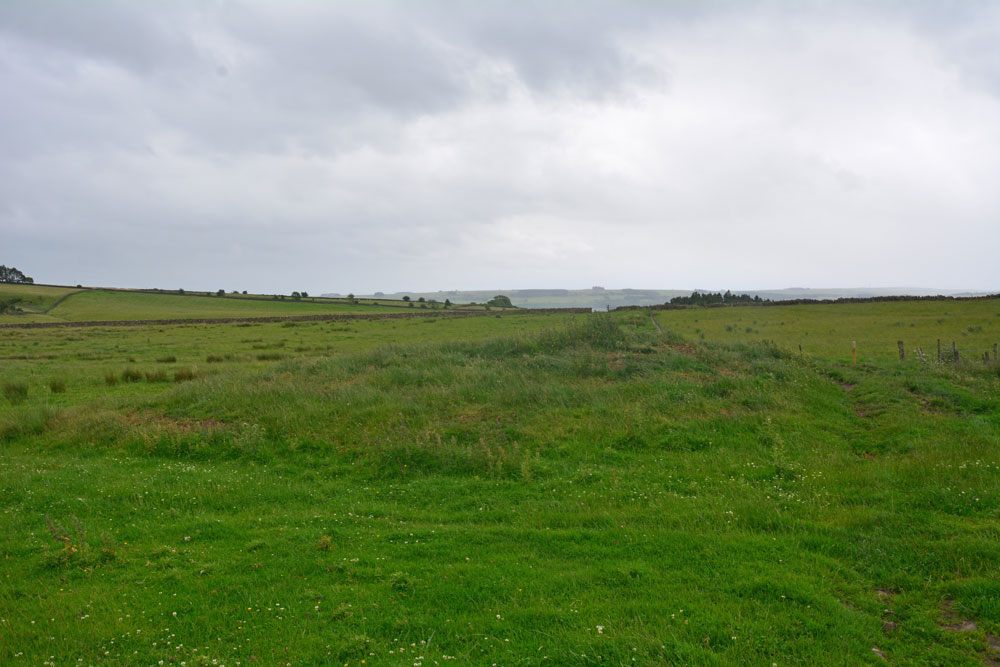
Joicey Shaft Cairn submitted by Anne T on 1st Jul 2019. The cairn as seen from the gate into the field at NY 82860 66456, showing how the farmer has driven his tractor over the western side of the mound, but the track 'bends' away from it, respecting most of the mound.
(View photo, vote or add a comment)
Log Text: Joicey Shaft Cairn: I spotted this mound almost by accident as I was photographing Joicey Shaft B from the track. At first I dismissed it as a manure heap, or possible tailings from the leading mining which used to take place here, but the more I walked round it, the more convinced I was it was a cairn, especially with its proximity to the rock art panels on the opposite side of the track, and because the modern field boundary and the track leading N-S to its western side 'bent' round to accommodate most of the barrow.
It is not recorded by HE or Pastscape, but it is on the old OS maps, so has been here for a while.
Smith's Shield Milestone
Trip No.142 Entry No.3 Date Added: 6th Jul 2019
Site Type: Marker Stone
Country: England (Northumberland)
Visited: Yes on 4th Jul 2019. My rating: Condition 2 Ambience 3 Access 4
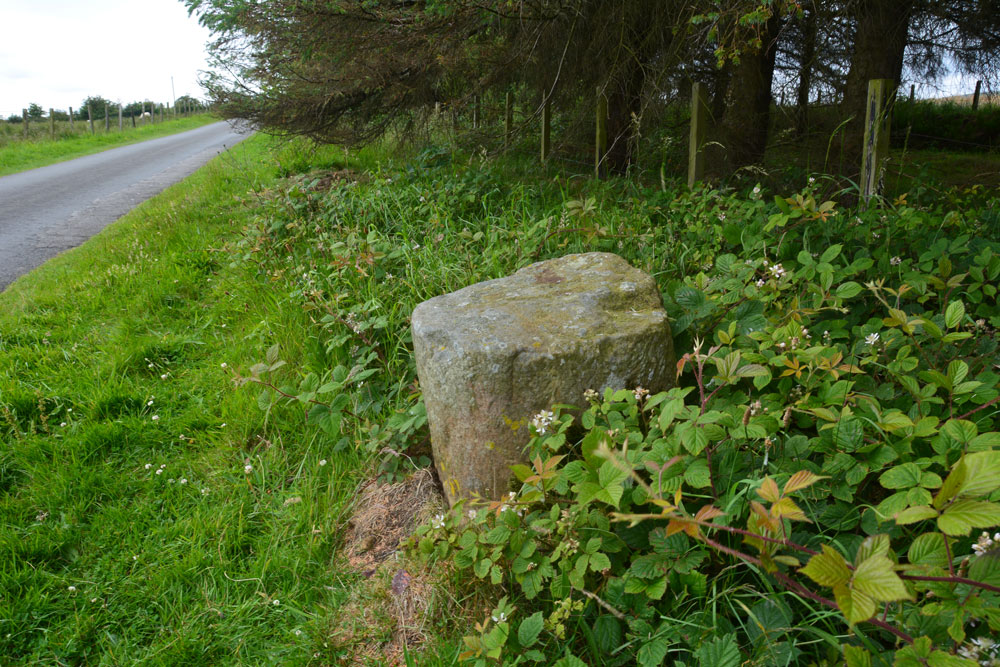
Smith's Shield Milestone submitted by Anne T on 6th Jul 2019. The base of the Smith's Shield Roman milestone, showing its location next to the minor road running east to Vindolanda. It is just over 100m east of the road junction which is just below Smith's Shield farmhouse.
(View photo, vote or add a comment)
Log Text: Smith's Shield Roman Milestone (base of): The base of this Roman milestone, located at the northern side of the road which runs east towards Vindolanda, is easy to spot.
A note of warning to future visitors - we had a run in with the AD122 local bus service who told us off for parking in what he thought was a passing place, but wasn't; there was plenty of room for him to pass, and he parked alongside us before he started yelling. I think he just wanted to shout at someone, but it certainly ruined my day.
There is a second, intact milestone at the eastern entrance to Vindolanda, which we have yet to go back and see.
Hadrian's Wall (Brunton Turret)
Trip No.142 Entry No.1 Date Added: 7th Jul 2019
Site Type: Misc. Earthwork
Country: England (Northumberland)
Visited: Yes on 4th Jul 2019. My rating: Condition 3 Ambience 4 Access 4
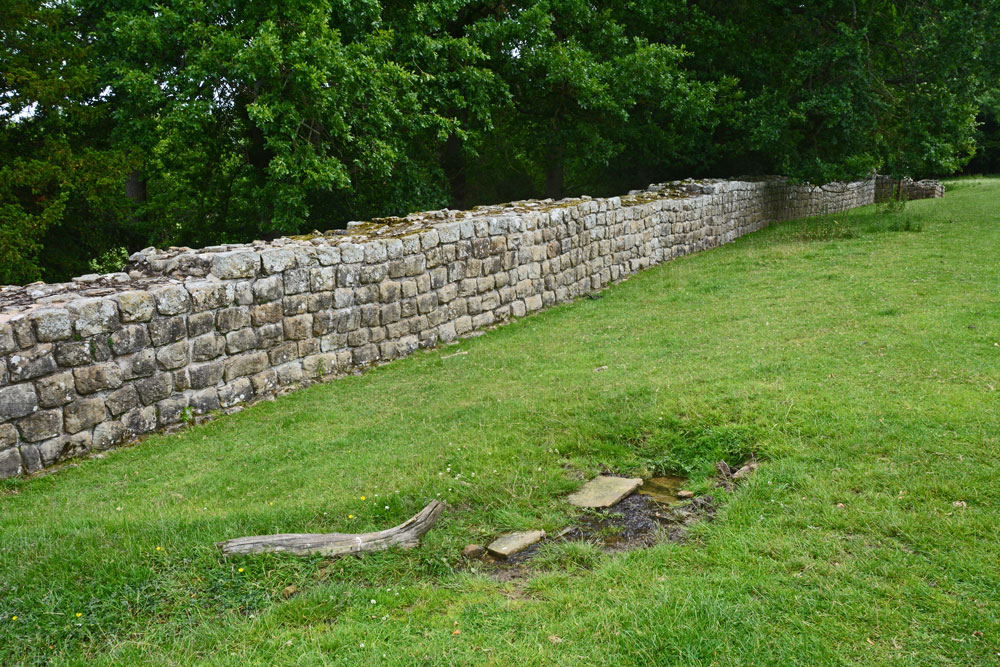
Hadrian's Wall (Brunton Turret) submitted by Anne T on 7th Jul 2019. Walking east along with wall, from near its south western corner. The small structure in the right/foreground is the spring, which was flowing freely at the time of our visit. There were the remains of some stone slabs around where it emerged from the ground.
(View photo, vote or add a comment)
Log Text: Brunton Turret 26b, Hadrian's Wall: Parked at the layby by the stile. We met a party of four Americans who were walking the wall and who had started at Newcastle on Monday, and from Corbridge this morning. I wished them a ‘happy 4th July’ and one of the ladies replied “Good job we’re friends again”, which raised a smile.
There was also a spring at NY 92109 69847 with the remains of a structure around it, flowing quite quickly and forming a small stream running downhill and round the bottom end of the turret.
The information sign at the top end of the site reads: ”Turrets were positioned equidistantly between largely milecastles where small garrisons of soldiers guarded gates that allowed for trave lthrough the Wall. Shortly after work on the wall started, large forts, such as Chesters, were also constructed to house garrisons of between 500 and 1,000 soldiers.
(Image) Right: layout of Brunton turret. The ‘curtain’ wall is a different thickness on each side of the turret. The turret was laid out with short ‘wing’ walls either side. These were supposed to be incorporated within the curtain wall once it was finished. But between completing the section of the Wall to the west and that to the east, the builders were ordered to narrow the curtain wall. This left about 1m of eastern wind-wall exposed”.
Hadrian's Wall (Chesters Bridge Abutment)
Trip No.142 Entry No.2 Date Added: 7th Jul 2019
Site Type: Misc. Earthwork
Country: England (Northumberland)
Visited: Yes on 4th Jul 2019. My rating: Condition 3 Ambience 4 Access 4
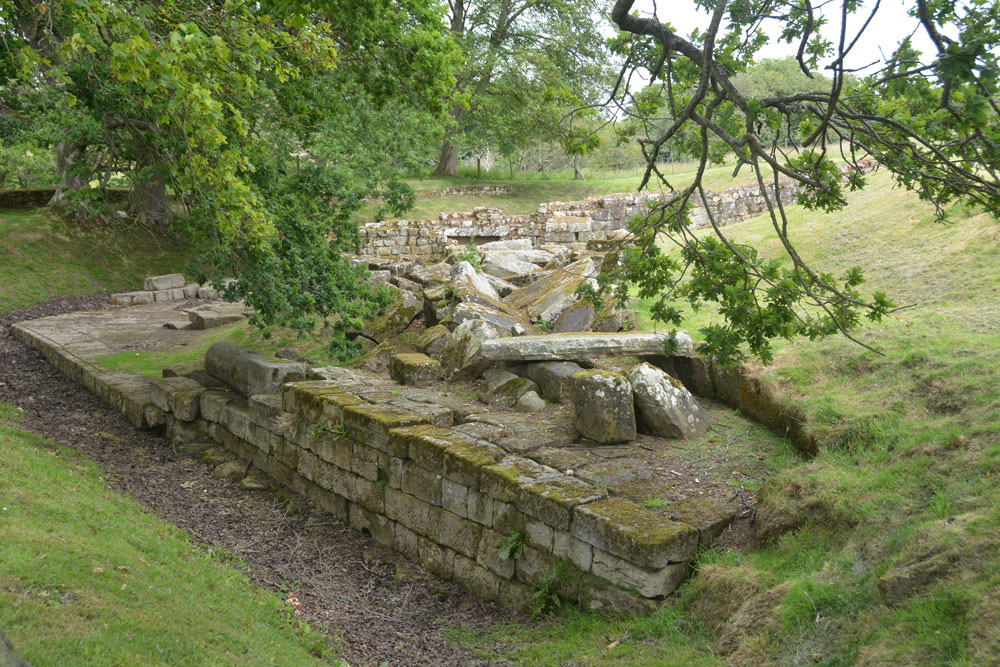
Hadrian's Wall (Chesters Bridge Abutment) submitted by Anne T on 7th Jul 2019. A look at the western side of the bridge abutment, giving an idea of its substantial structure and size. Behind me is a huge store of blocks which have fallen from the structure over the years and have been placed neatly waiting for restoration at some point?
(View photo, vote or add a comment)
Log Text: Chesters Bridge Abutment: It's been some time since we came here to photograph the rock art panel, which is still here (although heavily lichen covered). This is where “The River Hunters” did a search in their series not long ago, just opposite the bath house at Chesters on the opposite bank. This was visible from the bridge abutment.
We met the American party again and another gentleman who said he had been walking round the poppy field trying to get some good photos. I set him a challenge - looking for the phallus symbol and the rock art. He got quite excited about the symbol and told me that he walked the wall looking for these symbols. He'd recently been trying to find one near Gilsland but without success.
One of the sources used by Historic England is my book bought for £1 from Hexham car boot sale: Bruce, J C, Handbook to the Roman wall, (1863), 117-120 and Bruce, J C, Handbook to the Roman wall, (1863), 109-111
Chesters Roman Site b
Trip No.142 Entry No.2 Date Added: 7th Jul 2019
Site Type: Rock Art
Country: England (Northumberland)
Visited: Yes on 4th Jul 2019. My rating: Condition 3 Ambience 4 Access 4
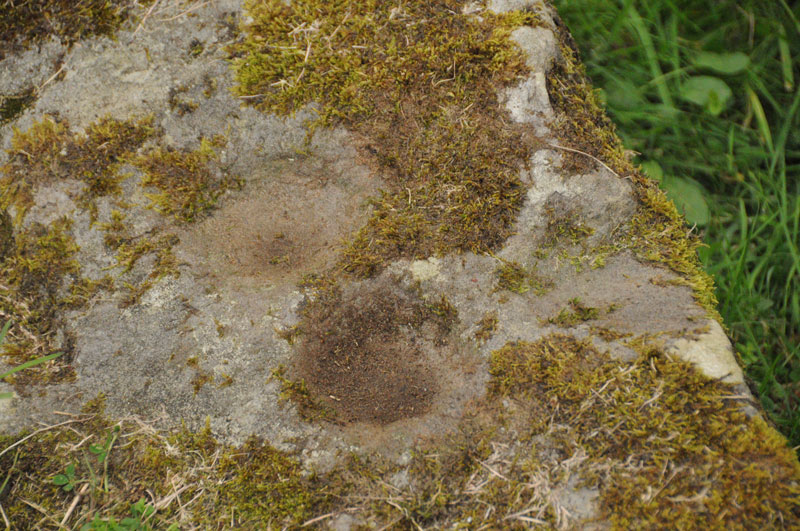
Chesters Roman Site b submitted by Anne T on 1st Sep 2014. Photograph showing two cup marks (0.09m) on stone, with third just on right hand edge.
(View photo, vote or add a comment)
Log Text: Chesters Roman Site b, Chesters Roman Bridge Abutment: Whilst we were here to photograph the bridge abutment, we took the opportunity to look for this panel again to see if it had changed. It was very much the same.
Hadrian's Wall (Poltross Burn)
Trip No.143 Entry No.1 Date Added: 11th Jul 2019
Site Type: Stone Fort or Dun
Country: England (Cumbria)
Visited: Yes on 8th Jul 2019. My rating: Condition 3 Ambience 4 Access 4
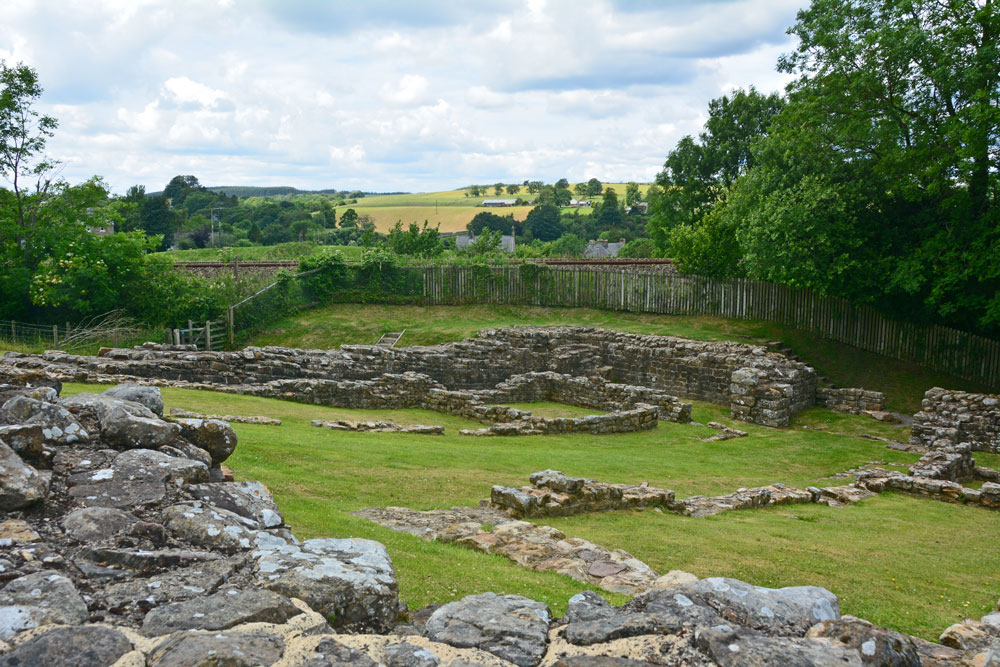
Hadrian's Wall (Poltross Burn) submitted by Anne T on 11th Jul 2019. Standing at the south western corner of the milecastle/small fort, looking towards its north eastern corner.
(View photo, vote or add a comment)
Log Text: Poltross Burn Milecastle: We last visited this site on 27th October 2013, and it hasn’t’ changed at all. Andrew, in typical engineering fashion, went round and talked about the offsets and revetted construction of this small fort. It’s layout is remarkably easy to read.
Andrew recalled reading about a house built right on top of the wall, but we were unable to find it.
Hadrian's Wall (Turret 44b)
Trip No.143 Entry No.3 Date Added: 11th Jul 2019
Site Type: Misc. Earthwork
Country: England (Northumberland)
Visited: Yes on 8th Jul 2019. My rating: Condition 2 Ambience 4 Access 4
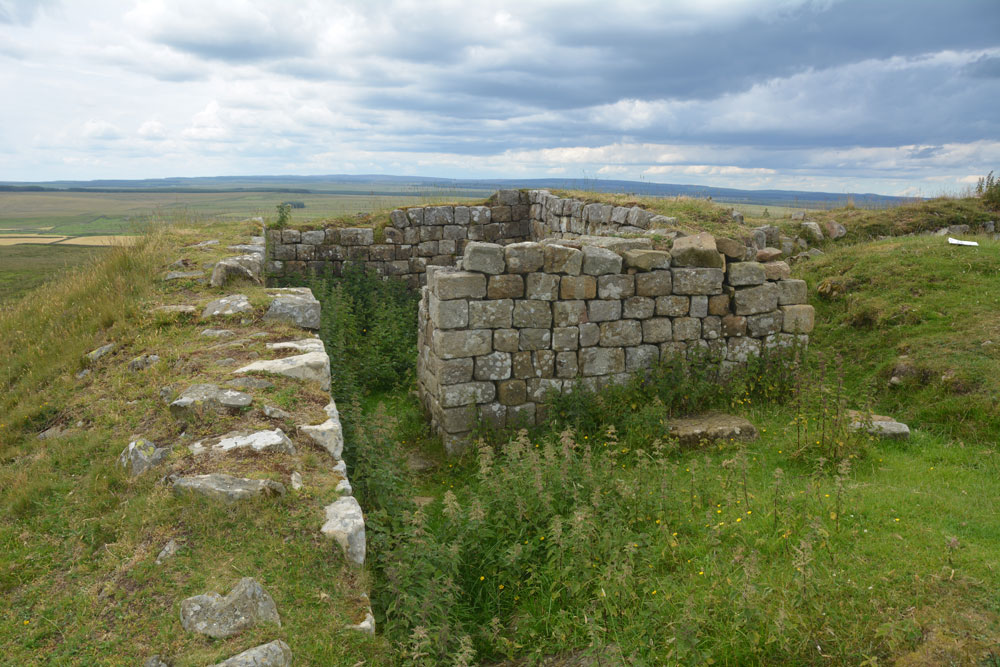
Hadrian's Wall (Turret 44b) submitted by Anne T on 11th Jul 2019. Standing almost at the western edge of the turret, with the crags dropping down sharply, just off shot to the left, looking north across the turret. Photo by Andrew T
(View photo, vote or add a comment)
Log Text: Turret 44b, Hadrian's Wall: Located on the crag above King Arthur's Well, this is a lovely spot. We had difficulty in locating the holy well, so whilst I continue to search for the it and see if I could find any structure or water course, Andrew ascended the steps to the top of the crag, and came back about 20 minutes later.
This turret is on the Hadrian’s Wall path, which runs almost due east-west here. It is in a very pretty spot. Even with it being a Monday afternoon, and a very warm day, there were lots of walkers here. Many passed me on the paved section of path but none appeared to stop and look at the turret, as no-one seemed to linger at this point. Perhaps they had already seen too many turrets around here - there are certainly a lot of them!
King Arthur's Well (Walltown Gap)
Trip No.143 Entry No.2 Date Added: 12th Jul 2019
Site Type: Holy Well or Sacred Spring
Country: England (Northumberland)
Visited: Yes on 8th Jul 2019. My rating: Condition 1 Ambience 4 Access 4
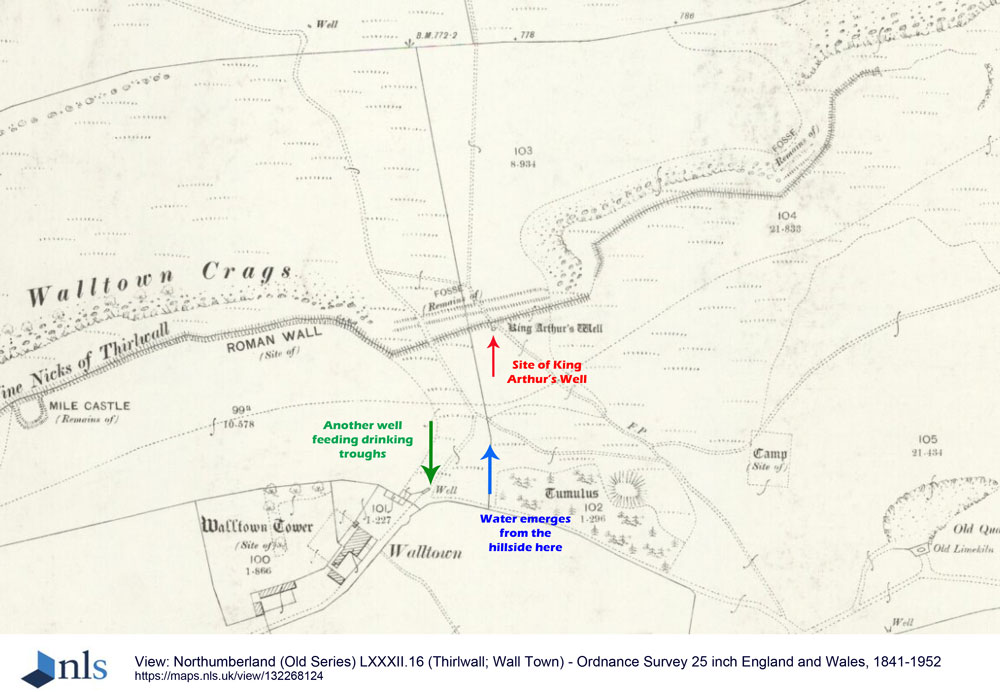
King Arthur's Well (Walltown Gap) submitted by Anne T on 12th Jul 2019. This is an image taken from the National Library of Scotland's 1895 OS map for Thirwall and Wall Town, dated 1895, and licensed for re-use under Creative Commons. Link: https://maps.nls.uk/copyright.html. The location of King Arthur's Well is marked by the red arrow, although if it exists is well hidden under turf and reeds. The blue arrow marks the location NY 68041 66551, where a spring emerges further down the hillside. The green arrow marks the location of another well which feeds drinking t...
(View photo, vote or add a comment)
Log Text: King Arthur's Well, Walltown Crags: Whilst this well may now be destroyed or lost, the scenery here is fantastic, and it was well worth coming out to look.
We were unable to find this holy well, despite having the GPS to guide us to the spot. However, we did see signs of reeds and tall grasses where the water might have pooled and flowed.
On the way up to the nick in the crags where the well is located, there is water emerging from the hillside at NY 68041 66551, which runs in a small stream down the slope, feeding two drinking troughs in the field below. We did visit after a period of prolonged dry weather, so wondered if the water emerges from higher up the hill after wet weather.
Carperby Cross
Trip No.144 Entry No.1 Date Added: 13th Aug 2019
Site Type: Ancient Cross
Country: England (Yorkshire (North))
Visited: Yes on 8th Aug 2019. My rating: Condition 3 Ambience 4 Access 5
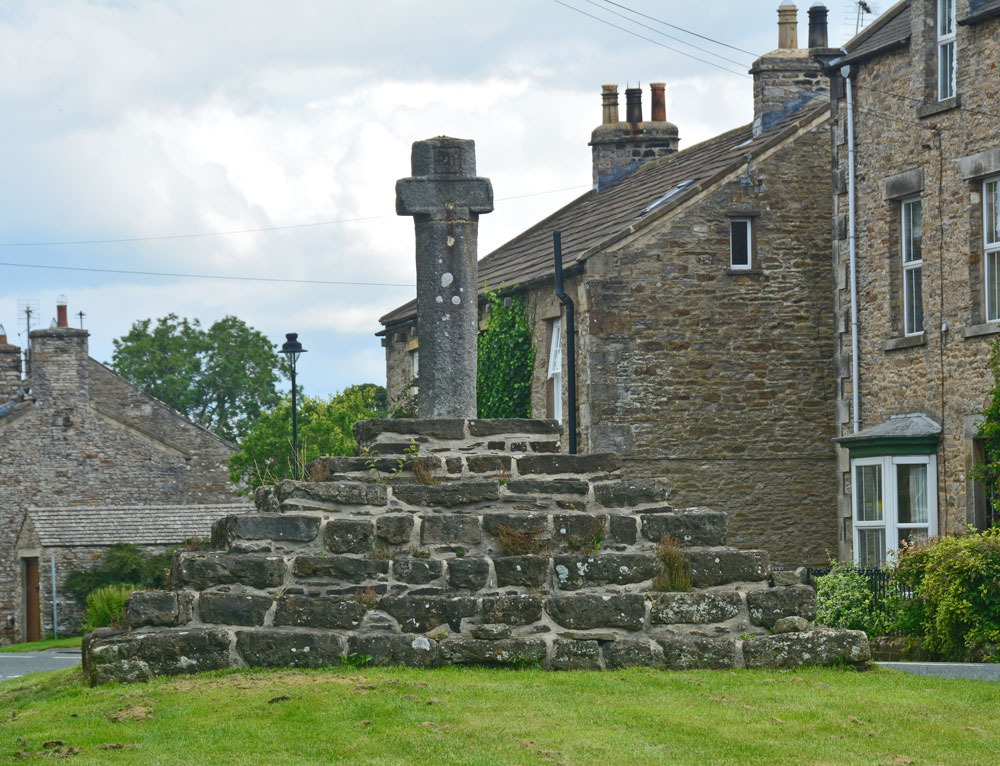
Carperby Cross submitted by Anne T on 13th Aug 2019. The cross from the village green, just to its western side, looking up the road through the village towards Redmire and Leyburn
(View photo, vote or add a comment)
Log Text: Carperby Cross: Not on our original schedule, we drove past this market cross and just had to turn back to take a closer look. Located on the village green in Carperby, which is a long, narrow, triangular strip of grass orientated SW-NE, the base or steps of the cross looked ancient, whereas the shaft of the cross looks modern, although it is dated 1674. The top of the cross has been broken off and re-cemented in at some stage. There are some interesting carved faces at the ends of the short, horizontal arms.
The information sign reads: “Carperby (West End). ‘Kerperbi’ is found in the Domesday Book of 1086. The name probably comes from early Scandinavian settlers, with ‘-by’ meaning farmstead and ‘kjarr’ meaning a bushy, boggy area, in old Danish.
Carperby has been designated as a Conservation Area because of its important historic character. The village is unusual in that it has two distinct centres, one at this end around the 17th century market cross and one at the east end where the original medieval manor house may have been.
The Market
The Market Cross suggests that Carperby’s medieval markets were held here but research shows otherwise. The original site at the far end of the village seems to have fallen into disuse after 1587 when Askrigg began to corner trade in the upper dale. It was briefly revived again in the 17th century, but this time at this end of the village. The date of 1674 carved on the cross supports this theory.
Religion
From the mid-17th century, non-conformism began to sweep through the Yorkshire Dales. The first converts worshipped in each other’s houses but eventually they built their own chapels.
West Lea Cottage was the first Methodist chapel, built in 1826. A little further east is its 1890 replacement (Greygarth), a simple Gothic building.
The Grade II listed Friends Meeting House of 1864 is the most sophisticated looking building in the village, with its heavily carved stonework. It seems to have replaced an earlier meeting house (Quaker Cottages) licensed in 1828 but later converted into cottages.
Education
Formal education in Carperby was provided by the school (Quarter House). It looks to be of 19th century date and the school records go back to 1870. A shaped tablet between the windows is inscribed ‘Carperby School’ but the rest is hidden by the later porch roof. The school closed in 1962.”
Sleights Pasture Propped Stone
Trip No.144 Entry No.2 Date Added: 13th Aug 2019
Site Type: Rock Outcrop
Country: England (Yorkshire (North))
Visited: Yes on 8th Aug 2019. My rating: Condition 3 Ambience 4 Access 4
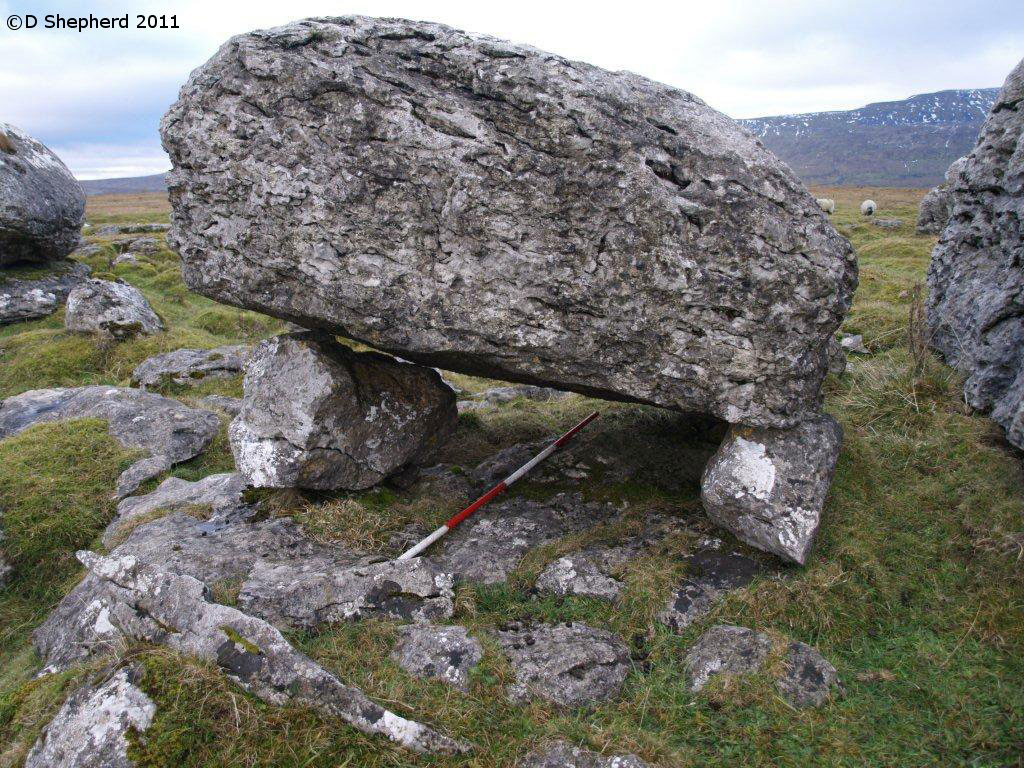
Sleights Pasture Propped Stone submitted by DavidShepherd on 10th May 2018. Sleights Pasture Propped Stone, photo by David Shepherd
(View photo, vote or add a comment)
Log Text: Sleights Pasture Propped Stone: We parked at SD 75081 78117, just beyond the cattle grid on this single-tracked public road (there is room for a couple of cars between the road and the stone wall) then along the very busy, and fast, B6255 Low Sleights Road, walking NE towards the Ribblehead Viaduct, then crossing the road to the footpath leading to this limestone scar, then heading SE along another minor footpath, marked on the map, but barely visible on the ground.
As there were several possibilities of which this propped stone might be, I made doubly sure I had the correct GPS and we were within 1m of the reading. We also compared it with the photograph on the Portal and the diagram (figure 7, in David’s paper “Propped Stones: The Modification of Natural Features and the Construction of Place” (Time and Mind, November 2013)) - I'd taken a copy with me, just in case.
Sorry, but I’m really sceptical about this being a propped stone. I would have been convinced if the propping stones were of a different material to the top stone. It looked like a ‘happy accident’ of glacial deposits and erosion. Another large boulder to its west was placed almost symmetrically on top of a ‘base pad’ of bed rock, and we spotted another couple of stones that also might have been taken as being propped. It reminded me very much of the ‘Guide Stones to the Great Langdale Axe Factory’, where it was difficult to pick one guide stone out of so many on the ground.
I also wasn’t convinced about the double propping, unless I have misinterpreted what David means about this. The boulder at the western end of the stone appeared to be cracked through, viewed from the north, rather than being two separate boulders on top of each other. Both propping stones were placed/located onto top of a bed of limestone.
There was also a very mysterious wall at SD 75748 78030, which Andrew pointed out, partly built with limestone pavement blocks for its ends. Looked like a sheep shelter to me.
Keld Bank (Ingleborough)
Trip No.144 Entry No.3 Date Added: 13th Aug 2019
Site Type: Rock Art
Country: England (Yorkshire (North))
Visited: Yes on 8th Aug 2019. My rating: Condition 3 Ambience 4 Access 3
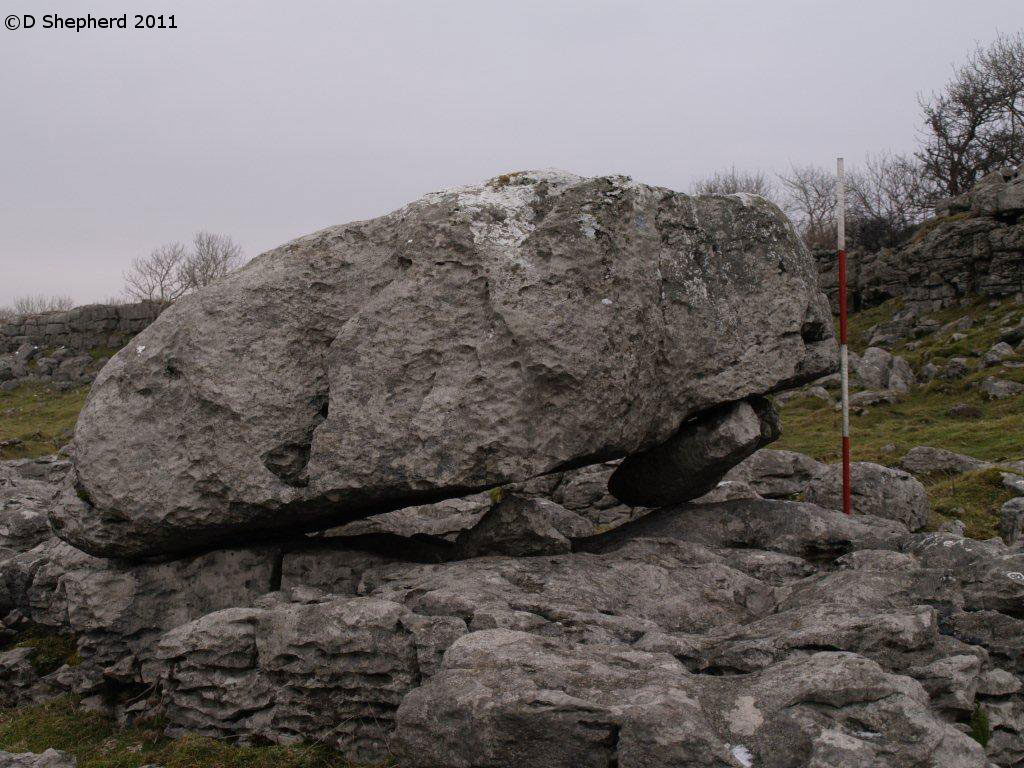
Keld Bank (Ingleborough) submitted by DavidShepherd on 10th May 2018. Keld Bank Propped Stone, photo taken by David Shepherd.
Top stone seems to have come from the adjacent collapse feature on the scar. There is an enlarged joint beneath blocked with a flake.
(View photo, vote or add a comment)
Log Text: Keld Bank Propped Stone: We parked in the small car park for Great Douk Caves on the northern side of the B6255, Low Sleights Road, and began by following the footpath up to the caves, passing the lime kiln on the way. We then largely followed a quad bike track SSE up the slope to the first limestone scar, then headed north east towards the grid reference given by David Shepherd.
The piece of land this propped stone sits on is a nature reserve, managed by Natural England, so we assumed we were safe to walk up over the limestone ridges or scars, of which I counted three. There were easy routes up over each raised section of scar, so I made the walk to the stone easily. Again, we needed to use the GPS and David’s photograph to confirm we were looking at the correct stone, as there were a number of possibilities in the area, including one nicely ‘balanced’ stone nearby.
My comments about this propped stone as the same as above. Even Andrew was less convinced this time, given there were so many other stones around that could also have been counted as ‘propped’ or ‘balanced’.
We ‘called off’ the walk for the third stone as a result of this visit, opting to go and find the stone circle at Casterton.
Keld Bank Settlement
Trip No.144 Entry No.4 Date Added: 13th Aug 2019
Site Type: Ancient Village or Settlement
Country: England (Yorkshire (North))
Visited: Yes on 8th Aug 2019. My rating: Condition 2 Ambience 4 Access 3
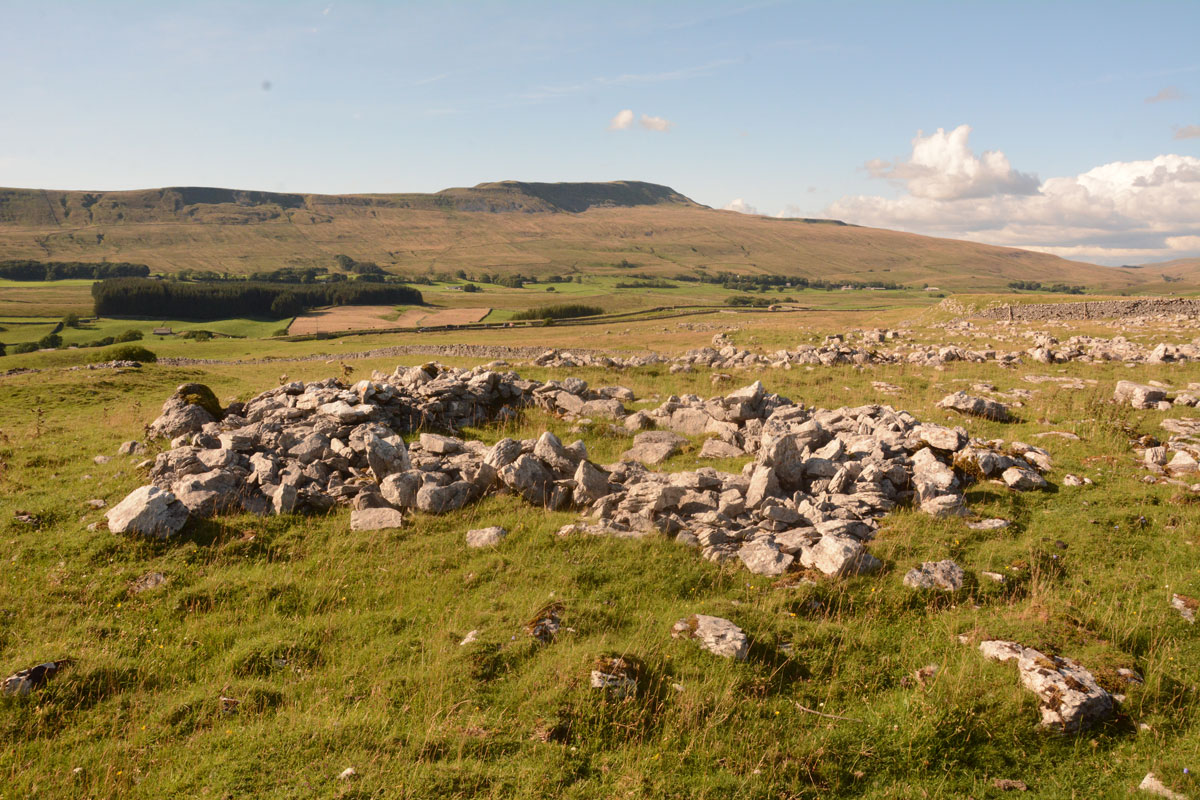
Keld Bank Settlement submitted by Anne T on 13th Aug 2019. The remains of the roundhouse, with an attached enclosure, on the western edge of the settlement. This view looks NW. On the terrace below, there are the remains of clearance cairns and the low banks of field systems
(View photo, vote or add a comment)
Log Text: Keld Bank Settlement: Sitting down in the sunshine, recording the photographs I’d taken for the Keld Bank Propped Stone, I picked up the OS map and realised there was a settlement here. In fact, where I’d chosen to sit, on the edge of a scar, was right on the eastern edge of it.
This settlement is marked on the HE map of the area, but not recorded or scheduled. It was very reminiscent of the Whittenknowles Rocks settlement on Dartmoor, where the walls and hut circles had been built round the natural stones/boulders. Built on the terrace just below the propped stone, extending to the terrace below. The sharp ‘edges’ of the terrace by the hut circle made it look a little like a hill fort – natural defences.
Towards the northern side, I identified a clear hut circle with an enclosure attached; this is clearly visible on UK Grid Reference Finder. There were other clearance cairns and the remains of old buildings and field systems in the terrace below the propped stones.
Casterton
Trip No.144 Entry No.5 Date Added: 13th Aug 2019
Site Type: Stone Circle
Country: England (Cumbria)
Visited: Yes on 8th Aug 2019. My rating: Condition 2 Ambience 3 Access 3
Casterton submitted by WindC on 26th Feb 2012. Looking eastwards, a moment when the cloud base lifted..
26/2/12
(View photo, vote or add a comment)
Log Text: Casterton Stone Circle and Settlement: I found this walk VERY difficult once we were in the field containing the stone circle, largely due to the steepness of the slope, but mainly due to all the stones and boulders hidden under the turf. I did not enjoy this visit at all, despite having really wanted to visit this stone circle.
We parked at SD 64084 79316 and walked northwards up the lane towards Brownthwaite Pike, a steady uphill plod, passing a spring which emerged from just the other side of the wall, and piped under the footpath to the field beyond.
Reaching the gate into the field with the stone circle, which the farmer allows access to, we had to wade through the first 10-15m, as water was trickling down the slope from across the footpath and pooling around the gate. I was quite astonished at all the heaps of stones (clearance cairns) and part-walls all across the field. It reminded me of the ‘5,000 tons of stones’ site in County Durham that Time Team looked at but couldn’t work out what it was.
On (finally) reaching the stone circle, which took the best part of 40 minutes, my interpretation was that this was a ring cairn, not a stone circle.
On the way back up the slope, did we find a boulder with cup mark? The interior was very smooth, unlike the solution holes, which have a rim. There was also another boulder with a large ‘solution hole’ on its side – an odd location for a solution hole.
Askrigg Cross
Trip No.144 Entry No.6 Date Added: 13th Aug 2019
Site Type: Ancient Cross
Country: England (Yorkshire (North))
Visited: Yes on 8th Aug 2019. My rating: Condition 3 Ambience 3 Access 5

Askrigg Cross submitted by Anne T on 13th Aug 2019. The market cross, looking west towards the church in Askrigg. The shaft dates from 1830, but the steps are 16th century, possibly earlier. Picture taken as dusk was rapidly falling, so not brilliant!
(View photo, vote or add a comment)
Log Text: Askrigg Market Cross and Water Pump: It was dusk by the time we arrived back in Askrigg, and just as I started to take photographs, a large Tesco ‘click and collect’ van pulled up right next to the cross. Typical. With all the cars parked around what must have been the old village green, it wasn't a brilliant spot to linger.
Hunterian Museum
Trip No.145 Entry No.1 Date Added: 29th Aug 2019
Site Type: Museum
Country: Scotland (North Lanarkshire)
Visited: Yes on 21st Aug 2019. My rating: Condition 4 Ambience 3 Access 4
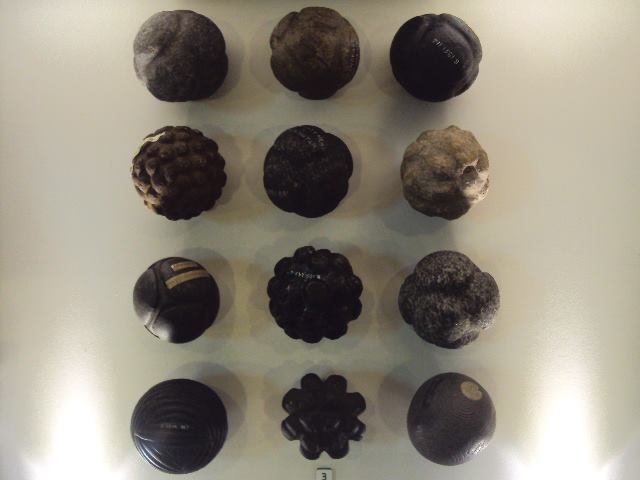
Hunterian Museum submitted by cosmic on 9th Jul 2013. The Hunterian Museum has one of the largest collections of carved stone balls in the country.
(View photo, vote or add a comment)
Log Text: Hunterian Museum: A (very) rainy day in Glasgow stopped us from going out on my 'well hunt', so we found our way to the Hunterian Museum, which I've always wanted to visit. The displays were nicely done, although the museum as a whole was a lot smaller than I anticipated.
I found the display on the Antonine Wall fascinating, along with some of the medical and scientific items on the first floor. At the time of our visit, the Royal College of Surgeon's building was closed (the website said until 2021, for redevelopment).
Unlike most museums, where you need to seek approval to post photographs, the Hunterian says: Photograph Policy: Our visitors are welcome to take photographs and video for personal, non-commercial use. We hope you will share them on your social networks! #hunterian (note: see their copyright statement on the line re works of art).
Note: the stone balls were not on display at the time of our visit.
Gilsland Spa Well
Trip No.146 Entry No.1 Date Added: 28th Aug 2019
Site Type: Holy Well or Sacred Spring
Country: England (Northumberland)
Visited: Yes on 27th Aug 2019. My rating: Condition 3 Ambience 3 Access 4
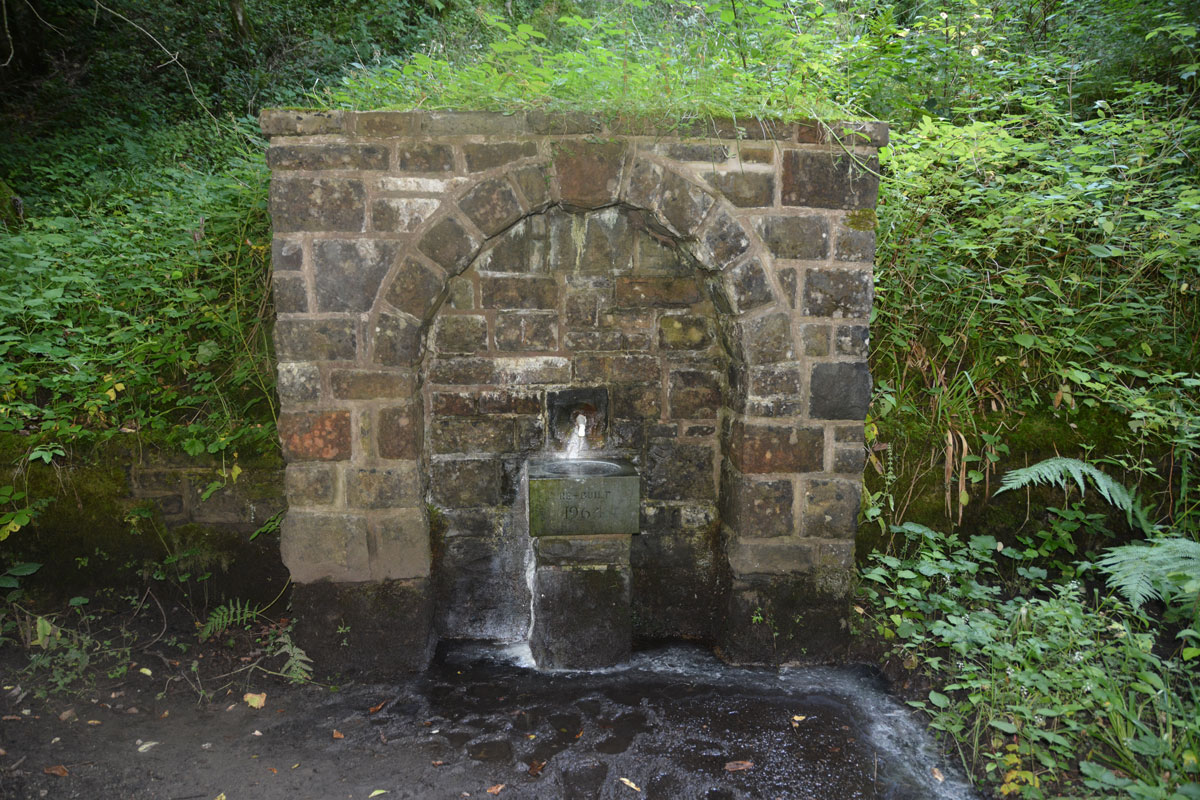
Gilsland Spa Well submitted by Anne T on 28th Aug 2019. Standing between the well structure and the river Irthing. The spring emerges from the base of a tall cliff, and smells strongly of sulphur. The plinth, basin and pipe/spout were rebuilt in 1964.
(View photo, vote or add a comment)
Log Text: Gilsland Spa Well: From the hotel car park, we followed the signs for the Sulphur Spa, leading on a path with a steep drop to our right hand side down to the River Irthing below. The path winds round to the left, then splits just above the southern side of the footbridge across the river. Take the right hand fork, walk about 20m, then take the small flight of steps down to the well, which can be smelt well in advance of reaching it!
The ground was very wet, with a steady flow of water coming out of the well spout. The eastern side of the well basin was covered with a white sulphurous stain, which carried on with the flow of water overflowing from the basin down to the river. I did dip my finger into the running water and had a quick taste. Very sulphurous, but not really unpleasant
As we approached the well, another couple were making a beeline from the well, coming from a path to the east. We fell into conversation, and it turned out they were from Doncaster (which is where I lived my early life), and lived near the race course. They were staying at the hotel for a week, returning home on Friday.
The path leading west from the well and the footbridge had been eroded away by the river. We got to within 120m of the sulphur spring, but not even Andrew wanted to walk this section of path; he said it would have been easier to walk along the river bed. We did try and see it from the other side of the river, but it was too heavily wooded to see anything.
This well is mentioned only briefly in the Springs of Living Water book by Fr John Muster, page 80, under the small section headed ‘Spa Wells’: “Though called holy wells, none are ever found identified with a saint. A good example is the one at Gilsland”. They have a photo on page 86.
No entries on Pastscape or HE, although if you type in the grid reference to the HE map search, it shows a circle where this well is located, and calls the general area to the west of the well a ‘Sulphur Spring’.
